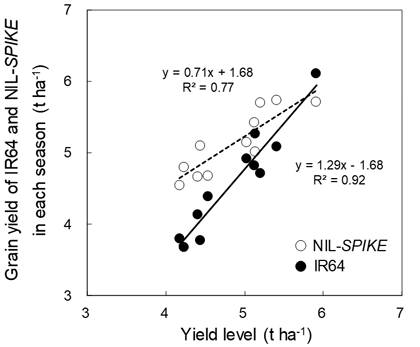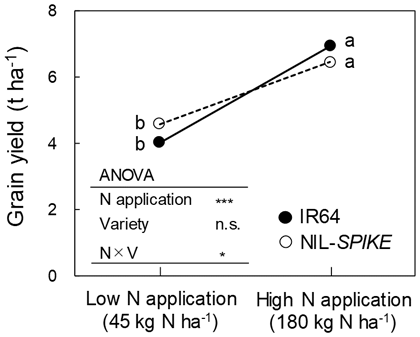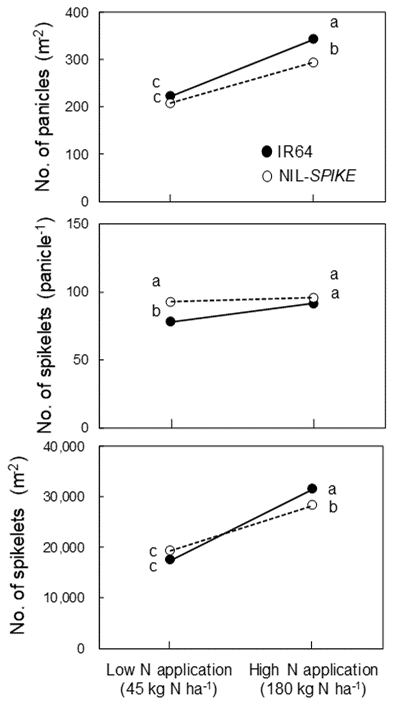SPIKE, a quantitative trait locus for increasing the number of spikelets per panicle, enhances rice grain yield under low-yield conditions
Description
Rice is an important food source in Asia and Africa; however, poor soil fertility and nutrient availability considerably limit rice production in these regions. In addition, the majority of local farmers lack the finances to purchase sufficient fertilizer. Therefore, it is necessary to develop genetically improved rice varieties with high nutrient-use efficiencies. Previously, a quantitative trait locus, SPIKE, was reported to have increased the number of spikelets per panicle in rice. Because tillering, and thus the number of panicles, is restricted under nutrient-poor soils, we expected that SPIKE may be useful in enhancing rice productivity under low-yield conditions.
In this study, we grew IR64 and the near-isogenic line (NIL) for SPIKE in the IR64 genetic background. They were grown in research plots at the International Rice Research Institute (IRRI) in the tropics across 11 seasons from 2011 to 2017, and in 2018 under high and low nitrogen (N) fertilizer conditions, where mean yield variation was 4.2–6.7 t ha-1. In multiseasonal trials, overall yield performance of NIL-SPIKE was 11% superior to that of IR64. Significant variety × season interaction clarified that NIL-SPIKE was superior to IR64 in the lower-yield seasons (< 5 t ha-1) but the difference decreased or disappeared completely in the higher-yield seasons (> 5 t ha-1) (Fig. 1). A subsequent N application trial with two levels of N fertilizer (45 and 180 kg N ha-1) confirmed a similar variety × N interaction for SPIKE; NIL-SPIKE tended to be superior to IR64 for grain yield under low-N application (4.3 t ha-1), while the difference disappeared under high-N application (6.75 t ha-1) (Fig. 2). The advantage of NIL-SPIKE under low-N application was due to more spikelets m-2 compared to IR64 but the difference disappeared under high-N application because there were fewer panicles m-2 in NIL-SPIKE compared to IR64 (Fig. 3).
The results of this study indicate that SPIKE is effective at increasing rice yield under low-yield conditions (< 5 t ha-1), namely low-N application or low soil fertility. Therefore, SPIKE should be used in breeding programs aimed at regions where soil fertility is poor, or where farmers cannot purchase adequate fertilizer.
Figure, table
-
Fig. 1. Comparison of grain yield between IR64 and NIL-SPIKE across 11 seasons.
Yield level shows mean yield between IR64 and NIL-SPIKE in each season. -
Fig. 2. Comparison of grain yield between IR64 and NIL-SPIKE under low- and high-N applications. *** and * show significance at 0.1% and 5% levels, respectively, while n.s. indicates not significant. Different letters show significant difference at 5% level.
-
Fig. 3. Comparisons of the number of panicles m-2, the number of spikelets per panicle, and the number of spikelets m-2 between IR64 and NIL-SPIKE under low- and high-N applications. Different letters show significant difference at 5% level.
- Affiliation
-
Japan International Research Center for Agricultural Sciences Biological Resources and Post-harvest Division
- Classification
-
Technical A
- Research project
- Program name
- Term of research
-
FY2019 (FY2010-FY2020)
- Responsible researcher
-
Takai Toshiyuki ( Biological Resources and Post-harvest Division )
Sasaki Kazuhiro ( Biological Resources and Post-harvest Division )
KAKEN Researcher No.: 70513688Asai Hidetoshi ( Crop, Livestock and Environment Division )
KAKEN Researcher No.: 30599064Fujita Daisuke ( Saga University )
KAKEN Researcher No.: 80721274Lumanglas Patrick D. ( International Rice Research Institute )
Simon Eliza Vie ( International Rice Research Institute )
Ishimaru Tsutomu ( Central Region Agricultural Research Center, NARO )
Kobayashi Nobuya ( Institute of Crop Science, NARO )
KAKEN Researcher No.: 70252799 - ほか
- Publication, etc.
-
https://doi.org/10.1007/s10681-019-2425-2
Takai T et al. (2019) Euphytica, 215:102
- Japanese PDF
-
2019_B04_A4_ja.pdf683.81 KB
2019_B04_A3_ja.pdf225.07 KB
- English PDF
-
2019_B04_A4_en.pdf117.74 KB
2019_B04_A3_en.pdf160.54 KB
- Poster PDF
-
2019_B04_poster_fin.pdf328.01 KB



